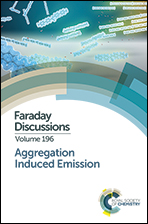A highly sensitive and selective fluorescent probe for hypochlorite in pure water with aggregation induced emission characteristics†
Abstract
As a reactive oxygen species (ROS), hypochlorite (OCl−) plays a crucial role in oxidative stress and signal transduction, controlling a wide range of physiological functions. In addition, the wide use of OCl− in the treatment of food and water might possibly threaten human health if the residual quantity was out of limits. Currently, sensitive methods employed to selectively monitor OCl− in aqueous samples in situ are still scarce and badly needed. Boron esters or acids are considered to be suitable functional groups for the detection of hydrogen peroxide due to their reliable reactivity. In this work, we try to develop a highly sensitive and selective OCl− probe (TPE2B) based on the mechanism of aggregation induced emission (AIE). Due to the distinct increase in water solubility of TPE2OH, which is generated from the reaction between TPE2B and OCl−, the strong emission of TPE2B is quenched dramatically. The response speed was as fast as 30 seconds with a detection limit as low as 28 nM. Additionally, test papers were also fabricated and exhibited a highly sensitive response to 0.1 mM OCl−.
- This article is part of the themed collection: Aggregation Induced Emission

 Please wait while we load your content...
Please wait while we load your content...